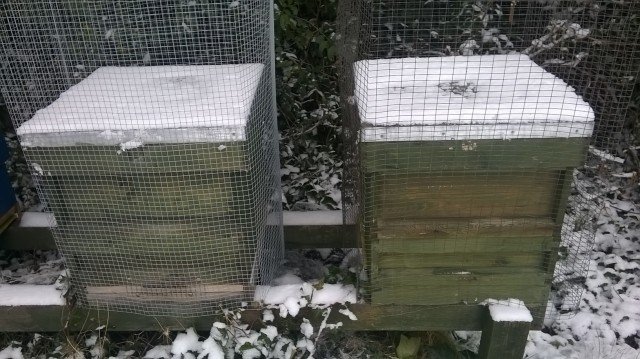
I like to visit apiaries occasionally during the winter to make sure colonies are ok as storms can cause damage with fallen trees etc. All colonies are ready for winter now with mouse guards, woodpecker netting and bricks on roofs. Weathermen consider December onwards as the start of winter so we have three months to go until spring arrives. It is important to heft colonies once in a while to see if they have much in the ways of stores. If a colony feels light it can be given fondant and the Association still has some Ambrosia fondant available. The fondant is priced at £15 per 12.5kg box with each box containing five individually wrapped 2.5kg blocks. Stockists are Philip Penman near Luton, Vicki Manners in Bedford and Neil Blakemore in Pavenham – see stockist details in the 2020 year book.
The Association has decided that members who wish to buy more than 5 packs of foundation next year will need to sell the equivalent weight in wax to the Association. So now is a good time to process that scrap wax that has accumulated over the season. Even collecting the scrapings from queen excluders, crown boards and super frames (top and bottom bars) can yield a reasonable amount of wax. The only place where wax is made is inside a beehive. So, in order to produce foundation, the equipment suppliers need to obtain the raw material – which comes from beekeepers! The Association holds several wax steamers which can be borrowed for free. When processing wax I place it in pieces of white garden fleece tied up into a bundle. The bundle is placed in the steamer and the wax comes out quite clean – good enough to trade in for foundation. See p36 of the 2020 Yearbook for members who hold steamers and other equipment.
Note that if you have unrendered wax it can be traded in without payment although it will count towards your extra foundation allowance.
As we approach xmas and the shortest day, I like treat for varroa with an oxalic acid type treatment. The books say there should be little or no brood around now although I have never inspected a colony to confirm this. Oxalic acid does not kill mites hiding in cells – only those on adult bees, hence the reason for applying it at around this time.
There are two ways of administering the acid – one by ‘trickling’ and the other by use of a vaporiser. Research shows that the vaporiser is a little more effective but requires specialist equipment, e.g. a car battery, face mask (the fumes are dangerous to humans and can damage lungs) and the actual vaporiser. So, I recommend applying it in the liquid form so as to avoid the possibility of acid damage. I have used the trickle method for many years and I have had good results in that time.
The Association does not hold any of the necessary protective equipment.
Some members have asked how should supers be stored to avoid wax moth. For many years I have kept them as follows:
- Place a couple of runners on the floor.
- Place a queen excluder on the runners (which will allow spiders to gain access to the super stack). The spiders should then deal with moths if they find their way into the stack.
- Make a stack with supers on the excluder, up to 12 for me as I can’t reach higher than that.
- Place a roof or a board on top of the stack to keep rodents out.
This method generally works well and I had only one year when a few supers were attacked by moths. It is also a chemical free system.
Lastly, seasons’ greetings to all and I hope to see many of you at the virtual AGM in February. With luck we will be able to meet up at some point in 2021 and even attend some outdoor events. Now that is something to look forward to!
Regards
Wally
